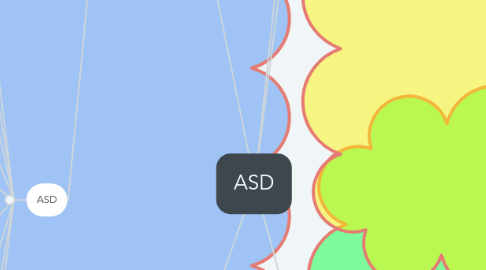
1. Diagnosis
1.1. Often Coincides with Social Communication Disorder
1.1.1. Deficits in functional limitations in effective communication, social participation, social relationships, academic achievement, or occupational performance.
1.1.2. Onset of symptoms in the early developmental period
1.1.3. Difficulties with verbal and nonverbal communication * Greeting and sharing information that is appropriate for social context is difficult * Impairment to change communication to match context or the needs of the listener (ex. slang versus formal language does not vary) * Difficulties for following rules for conversation and storytelling such as taking turns, rephrasing when misunderstood, knowing how to use verbal and nonverbal signals * Difficulties understanding ambiguous meanings such as idioms, metaphors, etc.
1.1.4. Symptoms are not attributed to another medical or neurological condition or to low abilities in the domains or word structure and grammar
1.2. ASD
1.2.1. Persistent deficits in social communication and social interaction
1.2.2. Deficits in social-emotional reciprocity
1.2.3. Deficits in nonverbal communicative behaviours used for social interaction
1.2.4. With or without intellectual impairment
1.2.5. With catatonia
1.2.6. With or without language impairment
1.2.7. Associated with another neurodevelopment, mental or behaviour disorder
1.2.8. Associated with known medical or genetic condition ro environmental factor
1.2.9. Deficits in developing, maintaining, and understanding relationships
2. Stereotypes can be present but not always - based upon social communication impairments
2.1. Restricted, repetitive motor movements, use of objects or speech
2.2. Insistence on sameness, inflexible adherence to routines or ritualized patterns or verbal nonverbal behaviour
2.3. Highly restrictive, fixated interests that are abnormal in intensity or focus
2.4. Hyper or hypo-reactivity to sensory input or unusual interests in sensory aspects of the environment
3. Timing and Correlation
3.1. May be present in early development but may not manifest until much later
3.2. Symptoms cause clinical significant impairment in social, occupational, or other important areas of current functioning
3.3. These distrubances are not better explained by intellectual disability or global developmental delay
4. Assessments
4.1. Consult
4.1.1. Psychologist
4.1.2. Family Doctor
4.1.3. Developmental Peditrician
4.1.4. Nurse Practitioner
4.2. Screening Tools
4.2.1. Autism Diagnostic Interview
4.2.2. Ages and Stages Questionnaires
4.2.3. Communication and Symbolic Behaviour Scales
4.2.4. Parent's Evaluation of Development Status
4.2.5. Modified Checklist for Autism in Toddlers
4.2.6. Screening Tool for Autism in Toddlers and Young Children
4.2.7. The Childhood Autism Rating Scale
5. Severity Levels
5.1. Level 3 Requiring very substantial support
5.1.1. Severe deficits in verbal and nonverbal communicatoin
5.1.2. Severe impairments in functing
5.1.3. Very limited initiation of social interactions
5.1.4. Minimal response to social overtures
5.1.5. Inflexible behaviour
5.1.6. Extreme difficulty with change
5.1.7. Restricted/repetitive behaviours interfere with functioning
5.1.8. Great distress/difficulty changing focus or action
5.2. Level 2 Requiring substantial support
5.2.1. Marked deficits in verbal and nonverbal social communication skills
5.2.2. Social impairments apparent even with supports in place
5.2.3. reduced or abnormal responses to social overtures from others
5.2.4. inflexible behaviour
5.2.5. Difficulty coping with change
5.2.6. Restricted/repetitive behaviours appear frequent to be obvious to the casual observer and interfere with functioning in a variety of contexts
5.2.7. Distress and /or difficulty changing focus or action
5.3. Level 1 Requiring support
5.3.1. Without supports, deficits in social communication cause noticeable impairments
5.3.2. Diffiuclty initiating social interactions
5.3.3. Inflexible behaviour causes significance interference with functioning in one or more contexts
5.3.4. Difficulty switching between activities
5.3.5. Problems of organization and planning
